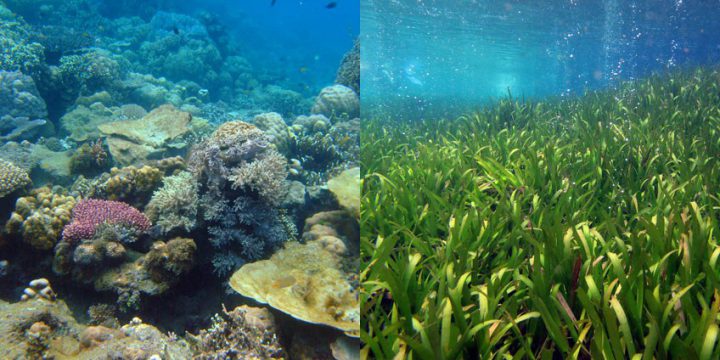What is ocean acidification?
The ocean of the future will be warmer and more acidic: how will this affect marine life?

By Richard Black
@_richardblackShare
Last updated:
How ocean acidification happens
The ongoing absorption of carbon dioxide (CO2) by the oceans is changing the chemistry of seawater.
Acidity, alkalinity and pH
- The pH scale is a measure of how acidic (or the opposite, known as basic) a solution is
- pH is a logarithmic measurement of the concentration of hydrogen ions (protons) in a solution. More acidic solutions have more hydrogen ions
- A pH of seven is neutral (neither acidic nor basic)
- The lower the number below seven, the more acidic the water; the higher the number above seven, the more basic
The natural pH of seawater is 8.2, which is slightly alkaline. But as seawater absorbs carbon dioxide from the air, it produces a weak acid and pushes the pH lower. Since pre-industrial times, the average pH of the ocean surface has fallen by 0.1 units to 8.1, which represents about a 30% increase in acidity.
Scientists are confident these changes in ocean chemistry are unprecedented in at least the past 65 million years, and possibly the last 300 million years. As human activities release more CO2 into the atmosphere, ocean acidification is forecast to continue.
If emissions are constrained tightly in the next decade and then fall to zero in the second half of the century (Representative Concentration Pathway, or RCP2.6), ocean pH is projected to fall by a further 0.05 units by 2100. With very high emissions (RCP8.5), however, the drop could be more like 0.35 pH units. The latter represents more than a doubling in acidity.
These are global average figures, and there will be variations from place to place. For example, pH in the Norwegian Sea and the Greenland Sea is falling faster than the global average.

Despite being one of the most studied topics in marine science, ocean acidification is less well known than other aspects of climate change. According to a survey in 2016, only one-fifth of the UK public are aware of it.
Impacts of ocean acidification
Some species are more susceptible to ocean acidification than others. The biggest threat is to ocean creatures with shells and skeletons made out of calcium carbonate. Higher acidity compromises shell growth and can cause larva to develop abnormally. This already affects many seafood favourites such as oysters, cockles, scallops, clams, lobsters, crabs and shrimp.
Some places in the ocean are ‘natural laboratories’ for studying ocean acidification. Here, carbon dioxide bubbling into the sea from underwater volcanoes makes the water unusually acidic, mimicking the effect of human-caused ocean acidification.
One of these areas is off the western coast of Italy; a second is in Papua New Guinea. In both places, sea life is characterised by the absence of shelled animals such as coral, and domination by seagrasses.

Acidification also appears to impede the capacity of some fish to hunt and to sense predators, by affecting their senses of hearing and smell. Other animals such as sea urchins may also be affected directly, though squid appear to have better capacity to adapt.
Impacts of acidification will be felt all the way up the food chain. For example, marine snails (pteropods), whose shells are now thinning in Antarctic waters and off the US West Coast, are an important feedstock for fish, squid and birds.
Will coral reefs survive?
Coral reefs not only face acidifying seawater as more carbon dioxide enters the atmosphere, but also higher temperatures.
Warm water can cause coral reefs to ‘bleach’. This happens when coral polyps expel the algae that live in them, as a direct consequence of warming up. The coral turns completely white. If the algae are not quickly reabsorbed, the coral will die. Extreme heat can also kill the coral outright, leaving the reef no opportunity to recover.
Temperature increases of only 1°C above normal for a few weeks during summer can induce bleaching. Studies show reef growth has fallen by 30% since 1998 in the Red Sea and by 27-49% since 1975 in the Great Barrier Reef owing to warming and acidifying waters. Between 2016 and 2018, record temperatures triggered a global mass bleaching event, causing the Great Barrier Reef in Australia to lose as much as 50% of its shallow water corals.
This has led to warnings that the world only has a small ‘window of opportunity‘ to preserve coral reefs. Scientists predict that 10-30% of tropical coral reefs could survive if global warming is limited to 1.5°C but virtually all (99%) would be wiped out with 2C of warming.
Coral reefs contain thousands of fish species, and are essential spawning, nursery, breeding and feeding grounds. Estimates of the biodiversity of coral reefs vary but they are thought to rival terrestrial rainforests.
Acidification and warming water will add to the stresses that reefs are already facing from disease, invasive species, direct damage from fishing and tourism, and pollution.
Impacts for humanity
Ocean acidification is already affecting human society.
Along the West Coast of North America, seawater that is naturally more acidic than average. The additional acidity caused by carbon dioxide emissions is now adding to the natural acidity and causing problems for shellfish farmers, with consequent financial losses.
In the UK, research suggests fish and shellfish stocks could fall by 10–60% by the end of the century due to warming and acidifying waters. In the short term, that could mean losses in revenue and employment in fisheries and associated industries of up to 20% by 2050.
Coral reefs are valuable economic resources, providing food, income and protection for millions of people living in tropical coastal areas. The UN Convention on Biological Diversity (CBD) estimates that 400 million people worldwide live within 100km of a tropical coral reef, and that damage to reefs by the end of the century alone would carry a loss of $1 trillion annually ($1000 billion).
Since seawater is absorbing CO2, the oceans slow the rate of climate change. However, the more it already contains, the less it can absorb. So the proportion of human emissions entering the ocean is decreasing, leaving more in the atmosphere to warm the planet.
Share
